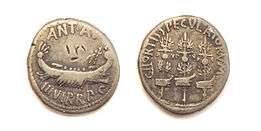Cohort (military unit)
 | ||||
| Part of a series on the | ||||
| Military of ancient Rome | ||||
|---|---|---|---|---|
| Structural history | ||||
|
||||
| Campaign history | ||||
| Technological history | ||||
|
||||
| Political history | ||||
|
|
||||
| Strategy and tactics | ||||
|
||||
|
| ||||
| Military organization | ||
|---|---|---|
 | ||
| Typical units | Typical numbers | Typical commander |
| fireteam | 3–4 | corporal |
| squad/ section |
8–12 | sergeant |
| platoon | 15–30 | lieutenant |
| company | 80–150 | captain/major |
| battalion/ cohort |
300–800 | lieutenant colonel |
| regiment/ brigade |
2,000–4,000 | colonel/ brigadier general |
| division/ legion |
10,000–15,000 | major general |
| corps | 20,000–40,000 | lieutenant general |
| field army | 80,000+ | general |
| army group | 2+ field armies | field marshal/ five-star general |
| region/ theater |
4+ army groups | Six-star rank |
A cohort (from the Latin cohors, plural cohortes) was the basic tactical unit of a Roman legion--about 500 soldiers, the equivalent of a modern battalion--which replaced the manipular system following the reforms traditionally attributed to Gaius Marius in 107 BC. Until the middle of the first century, 10 cohorts (about 5,000 men) made up a Roman Legion.[1]
Legionary cohort
Immediately after the Marian reforms, a Roman legion comprised ten cohorts, known simply as "the first cohort", "the second cohort" etc. The commanding officer of the First Cohort, the Primus Pilus or Senior Centurion, was the ranking centurion in a legion. The First Cohort also carried the legion's standard and the legionary Eagle into battle and, as a result, the cohort was considered to be the most senior and prestigious.
A cohort consisted of approximately 480 men in six centuriae of 80 men, each commanded by a centurion assisted by junior officers. At various times prior to the reforms, a century might have meant a unit of 60 to 80. The cohort had no permanent commander; it is assumed that in combat, the most senior centurion of the six would have commanded the entire cohort. In order of seniority, the six centurions were titled hastatus posterior, hastatus prior, princeps posterior, princeps prior, pilus posterior and pilus prior (most senior).
This followed the order of seniority in the earlier manipular legions, where the youngest and least experienced units were termed hastati, next principes, and the oldest and most experienced triarii (pilus was a rare alternative name for triarius, the singular of triarii).
During the 1st century AD, the command structure and make-up of the legions was formally laid down, in a form that would endure for centuries. The first cohort was now made up of five double-strength centuries totalling 800 men, the centurion of its 1st century automatically being the most senior in the legion. This century was known as the primus pilii (first files), and its centurion was known as the primus pilus (first file or first spear).
The legion at this time numbered about 5,400 men, including officers, engineers and usually a small unit of cavalry (equites; 120 men and horses).[2]
Types of cohort

Auxiliary cohorts could be quinquagenaria (nominally 500 strong) or milliaria (1000 strong).
- Cohors alaria: allied or auxiliary unit
- Cohors classica: auxiliary unit originally formed of sailors and marines
- Cohors equitata (LA): unit of auxiliary infantry with attached mounted squadrons
- Cohors peditata (LA): infantry unit
- Cohors sagittaria: infantry auxiliary unit of bowmen
- Cohors speculatorum (LA): guard unit of Mark Antony composed of scouts
- Cohors torquata (LA): auxiliary unit granted a torques (military decoration)
- Cohors tumultuaria (from tumultus, "chaos"): irregular auxiliary unit
Other Roman cohorts
Some paramilitary corps in Rome consisted of one or more cohorts, though none were part of a legion:
- The nine cohortes praetoriae, never grouped to a legion, the famous and infamous Praetorians. The term was first used to refer to the bodyguard of a general during the Republic; later, a unit of Imperial guards (temporarily restyled cohors palatina, "Imperial Cohort",[3] c. 300 AD, under Diocletian's tetrarchy).
- Cohors togata was a unit of the Praetorian guard in civilian dress tasked with duties within the pomerium (sacred center of the Capital, where all armed forces were forbidden).
- Cohortes urbanae, "urban cohort": military police unit patrolling in the capital.
- Cohortes vigilum, "watchmen": unit of the police force which also was the fire brigade in the capital.
- Cohors Germanorum (LA): the unit of Germani custodes corporis (imperial body guards recruited in Germania).
Furthermore, the Latin word cohors was used in a looser way to describe a rather large "company" of people (see, for instance, cohors amicorum).
See also
References
- ↑ http://homeworkhelp.stjohnssevenoaks.com/romans/Legio.html
- ↑ Goldsworthy, Adrian (2003). The Complete Roman Army. London: Thames & Hudson Ltd. ISBN 0-500-05124-0.
- ↑ "Hence adj. Pălātīnus -a -um Palatine; Apollo, whose temple was on the Palatine, Hor.; also relating to the imperial palace, imperial: Ov."—Simpson, D. P. (1968). Cassell's Latin Dictionary (5th ed.). New York: Macmillan General Reference. p. 420. ISBN 0-02-522570-7. Retrieved September 2, 2010.
External links
| Wikimedia Commons has media related to Ancient Roman cohortes. |